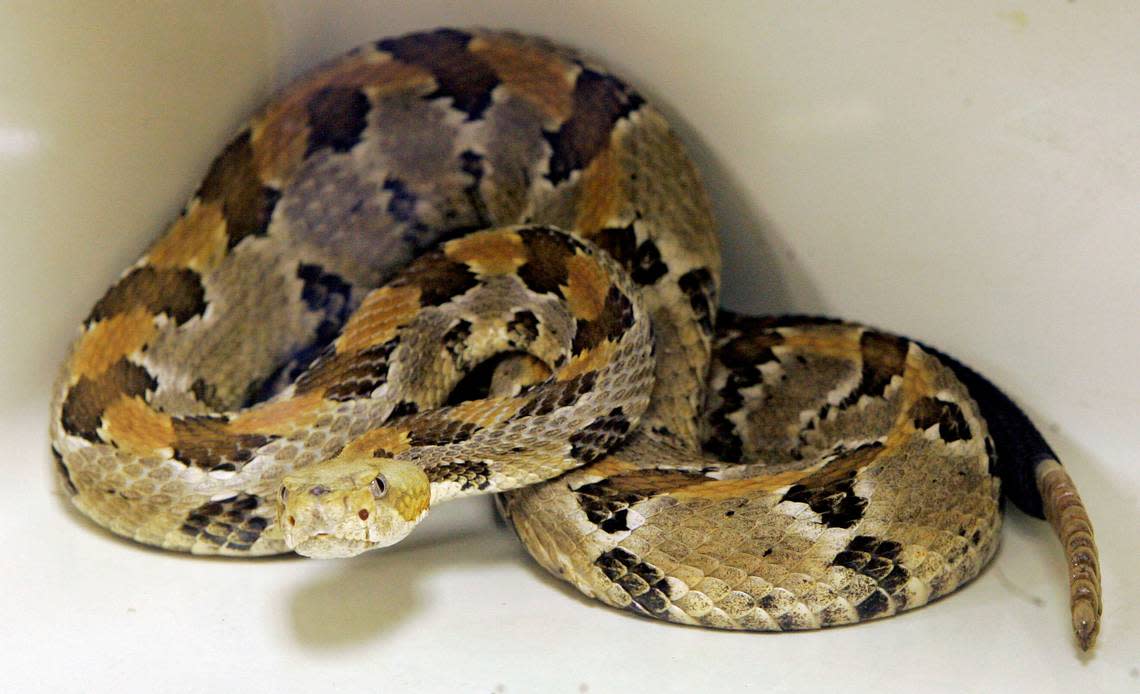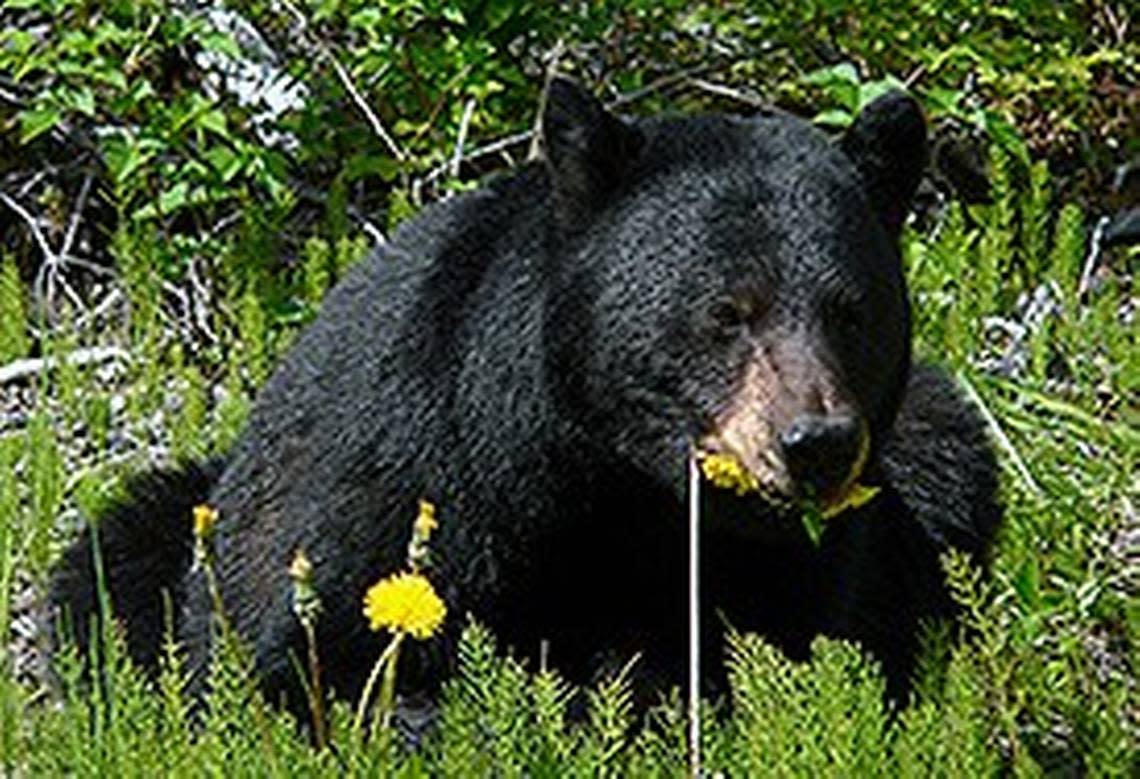7 critters you may cross while hiking in NC this summer, and what to know about them
Before hitting the trails this summer, you should get familiar with the animals you may encounter while you’re on them.
While there’s no reason to expect you’ll get in a tussle with a black bear or hear the signature sound of a rattlesnake near Lake Crabtree, you should know what to do if you encounter a dangerous animal on the hiking trail in the mountains or toward the coast this summer.
The N&O spoke with Falyn Owens, wildlife biologist for the NC Wildlife Resources Commission, to learn about the animals you might spot in North Carolina this summer, how dangerous they could be and how to behave if you do see one.
“For all animals in North Carolina, as cliche as it sounds, they are much more scared of us than we are of them,” Owens said. “No matter what you come across on a hike, it’s afraid of you and will run off if given the chance — except maybe ticks and mosquitos!”
Here’s what to know about North Carolina’s wildlife and where to spot them.
1. Copperheads on hikes in NC
For a deep dive on copperheads, read The N&O’s previous story: newsobserver.com/news.
Here’s the brief version of what to know about copperheads while on hikes:
• Location: All across North Carolina, very common in the Triangle.
• What to know: Copperheads are venomous snakes, and they are the only venomous snake you are likely to encounter in the Triangle. Their bites can be painful and expensive to treat. Bites can damage tissue, though they are almost never fatal. If you are bitten by a copperhead, seek medical treatment immediately.
• Appearance: Copperhead snakes are brownish-gray in color with an hourglass-shaped pattern on their backs, which resembles a Hershey’s Kiss. Newly born or very young copperheads will resemble their parents — except they’ll have a bright yellow or greenish-tipped tail that darkens pretty quickly. Adult copperheads grow to about three feet long.
• Warning signs: Copperheads will warn you that you’re getting too close to them by coiling up and getting ready to strike you.
• What to do: If you see one, leave it alone. Do not touch it. Keep a sharp eye for snakes while outside, and be sure to always know where you’re stepping (especially if you’re wearing open-toed shoes). Wear gloves when reaching into weeds, bushes or pine straw.
• With dogs: Keep a close watch on dogs who might poke their noses into spots where copperheads may like to rest.
• Learn more: ncwildlife.org/Learning/Species/Reptiles
2. Rattlesnakes on hikes in NC
There are three types of rattlesnakes — Timber “Canebrake,”, Eastern Diamondback and Carolina Pigmy — in North Carolina. For a deep dive into all three, visit The N&O’s previous story at newsobserver.com/news.
Here’s what to know about rattlesnakes while on hikes:
• Location: Rattlesnakes are not found in the Triangle, but mostly in the western and eastern parts of the state. Closest to the Triangle, the Timber Rattlesnake can be found in Harnett County, bordering the southwestern portion of Johnston County
• What to know: Venom from a rattlesnake bite is highly toxic, making it more dangerous than venom from a copperhead, but the bites are far less common. Though North Carolinians have died from rattlesnake bites. If you are bitten by a rattlesnake, seek medical attention immediately.

• Appearance: The Timber Rattlesnake, which is the rattlesnake most likely to be seen closer to the Triangle, is large and heavy-bodied, and it can be up to five-and-a-half feet long. In the Piedmont and Coastal Plain, the snakes are usually light brown, gray, tan or with a pinkish background. In the mountains, they are usually yellow, dark gray or black. They have dark crossbands on a lighter background, and their tails — which have a rattle on the end — are usually black.
• Warning signs: Listen for the rattle, it’s the snake’s way of telling you that you’re too close and it’s afraid. Snakes in North Carolina only bite people in self-defense and when they have no other option for avoiding harm. Even some non-venomous snakes (including our common black racer) will vibrate their tail as a warning signal to back away.
• What to do: Back off when they “ask” you to. The best way to avoid any snake bite is to watch where you step or reach, and give snakes plenty of space.
• With dogs: Keep a close watch on dogs who might poke their noses into spots where rattlesnakes may like to rest.
• Learn more: ncwildlife.org

3. Black bears on hikes in NC
You may spot a black bear at this time of year around the Triangle, but this isn’t their home year-round.
“Newly independent yearling male bears are most likely to be spotted in the Piedmont, as they are wandering around, likely because they are lost trying to establish their own territory after getting kicked out of their mom’s home,” Owens said.
Bears are highly motivated by food and will come near humans for an easy snack. One of the best ways to avoid bear encounters is to pack up food entirely when leaving an area, and never feed a bear (including accidentally).
“Bears are smart and can remember that humans equal food. Don’t let them know that,” Owens said.
Here’s what to know about black bears while on hikes:
• Location: In the mountains year-round. Black bears may be in/near the Triangle in late spring (May and early June) as they’re settling into parent-less life.
• What to know: Black bears are inclined to actively avoid contact with people, but they can be aggressive and unpredictable, particularly if cubs are present. It’s rare they become aggressive when encountered, and attacks are uncommon, according to black bear website BearWise.
• Appearance: A black bear has a long snout, rounded ears, and small eyes. In the Southeast, bears are mostly black and often have a brown snout, BearWise says.
• Warning signs: If your presence causes the bear to change its behavior (stops feeding, changes its travel direction, watches you, etc.) you are too close. Being too close may promote aggressive behavior from the bear such as running toward you, making loud noises or swatting the ground. The bear is demanding more space, according to the National Park Service.
• What to do: Don’t run, but slowly back away, watching the bear. Increase the distance between you and the bear. The bear will probably do the same. If you are physically attacked, fight back aggressively and do not play dead.
• When, how to use bear spray: Bear spray is a powerful deterrent made of capsaicin (the “hot” in hot peppers), which can deter bear attacks when correctly used, says BearWise. Bear spray inflames the bear’s eyes and upper respiratory system, causing intense burning and giving you and your loved ones time to escape. If the bear approaches within 20 and 30 feet, spray using both hands following the manufacturer’s directions. Aim directly in front of the bear’s head and a little downward. A cloud of ingredients will billow up from the ground, creating a wall of spray that the bear will feel when it reaches the cloud.
• With dogs: Bears can harm dogs that run up to and/or bark at them, so keep your dogs on leashes at all times. This is especially important during the late-spring in Piedmont-area hiking trails.
• Learn more: bearwise.org/bear-safety-tips
4. Ticks on hikes in NC
The most commonly found ticks in North Carolina, according to NC State, are the American Dog tick, the Brown Dog tick, the Lone Star tick and the Black-legged tick (deer tick). Dive deep into learning about ticks with The N&O’s previous story: newsobserver.com/news.
Here’s what to know about ticks while on hikes:
• Location: All across the state, including in the Triangle.
• What to know: Ticks can carry potentially fatal illnesses and can transmit them to humans through bites”
Rocky Mountain Spotted Fever can be carried by the American dog tick (the most common carrier in NC), the brown dog tick, and the Rocky Mountain wood tick.
Lyme disease is transmitted to humans by the bite of an infected blacklegged tick (or deer tick), and there have been documented cases in North Carolina. Typical symptoms include fever, headache, fatigue and a “bull’s eye”-shaped skin rash. Most cases of Lyme disease can be treated successfully with a few weeks of antibiotics, but if left untreated, infection can spread to joints, heart and the nervous system.
STARI stands for “southern tick associated rash infection,” and you can get it from a Lone Star tick. It can present itself as a rash that looks similar to Lyme disease.
• Appearance: Ticks are so tiny they can easily be confused with a freckle. You most likely won’t see one while hiking, and you’ll only identify it after it’s already on your body. Many victims don’t even recall getting bitten. While not all ticks carry disease, it’s definitely important to save any tick that has bitten you by placing it in a ziplock bag and storing it where you can easily find it. If you develop any signs of illness that may be related to the tick bite, your doctor may be able to test the tick for diseases.
• Warning signs: Watch for symptoms over the next 30 days, including fevers, rashes, tiredness, headaches, nausea, vomiting and muscle aches.
• What to do: When going out for your hike, use repellents that include an EPA registration number on the label to prove it has been tested. Steer clear of brushy, wooded areas with lots of leaves and high grass (where ticks live). Walk in the center of trails. When you get home, perform a thorough tick check, especially these spots: under the arms, in and behind the ears, in hair, in the bellybutton, between the legs, around the waist and behind knees. Tumble-dry clothing for 10 minutes.
• With dogs: Use a tick preventative medication for your pet. After pets spend time outside, be sure to check them for ticks, paying close attention to the following spots: In and around the ears, around the tail, around the eyelids, under the collar, under the front legs, between the back legs and between the toes.
• Learn more: cdc.gov/ticks/avoid
5. Coyotes on hikes in NC
Dive deep into learning about coyotes with The N&O’s previous story: newsobserver.com/news.
Here’s what to know about coyotes while on hikes:
• Location: All across the state, including in the Triangle.
• What to know: Attacks on humans are very rare, but coyotes can attack pets like small dogs and cats, as they can easily be mistaken for coyotes’ natural prey (rabbits and rodents).
• Appearance: They are wild canines that weigh about 30 pounds. Coyotes are typically gray or light brown, though they can be black as well.
• Warning signs: During pup rearing season (which is typically in May), coyotes may be near their dens and will want to protect their pups. If a coyote doesn’t run away when spotting you, it’s likely because its pups are nearby.

• What to do: Coyotes can almost always be shooed away by “hazing it.” This can include making loud noises, waving your arms or throwing small items in its direction (not at the animal). Coyotes are afraid of humans, so any attempt to scare them off will work 99% of the time.
• With dogs: Keep pets leashed or inside a fenced area. Feed pets indoors, and remove uneaten food when your pet is finished eating. Coyotes are classified as carnivores and are known to eat small and medium-sized pets, as they’re similar to the rabbits and other small mammals they eat.
• Learn more: ncwildlife.org/Learning
6. Mosquitoes on hikes in NC
Dive deep into learning about mosquitoes (and how to avoid getting bitten) with The N&O’s previous story: newsobserver.com/news.
Here’s what to know about mosquitoes while on hikes:
• Location: All across the state, including in the Triangle.
• What to know: For most of us in North Carolina, mosquito bites are painful, itchy bumps that take a few days to heal. But mosquitoes are categorized worldwide as the deadliest animal, killing over 700,000 people annually through the diseases they carry and spread. They can also infect our pets with heartworms.
• Appearance: The Asian tiger mosquito is one of more than 40 types of mosquito found in our area, and it’s easily identified by its white-and-black striped legs and body, says NC State. It can spread diseases to humans and animals, including West Nile Virus and Eastern Equine Encephalitis.
• What to do: Use body sprays with DEET, and cover your skin. If you’re in a heavy-mosquito area, you may want to wear netting.
• With dogs: Dogs can get swollen, itchy mosquito bites just like humans can. But the greater danger is heartworms, which are transmitted solely through mosquito bites. Ensure you’re giving your dog a heartworm preventative. Without it, dogs are vulnerable to infection, which could be fatal if left untreated, says Veterinary Emergency Group.
• Learn more: cdc.gov/ticks/avoid
7. Frogs and toads on hikes in NC
Unlike all the other animals mentioned, frogs and toads are the animals that can be harmed when interacting with them on hikes. North Carolina doesn’t have any poisonous frogs that can harm humans, Owens said.
“One thing that’s helpful to know: If you pick up a frog, it’s probably going to pee on you. It’s the most dangerous thing that can happen. It’s a defense mechanism and that’s all it has to protect itself.”
Here’s what to know about frogs and toads while on hikes:
• Location: All across the state, including in the Triangle.
• What to know: They are harmless to humans, but humans are harmful to them. Substances on our hands (such as insect repellent, lotion, hand sanitizer or soap residue) can be absorbed through their skin, which is how they breathe.
• Appearance: Frogs and toads can be smooth or warty. They don’t have tails, and they have webbed hands and feet that help them jump and swim.
• Warning signs: Frogs urinate when they’re picked up as a defense mechanism.
• What to do: Let frogs and toads be in their habitats undisturbed. If you do want to pick up a toad or frog, wear gloves or ensure your hands are freshly washed (not cleaned with hand sanitizer).
• With dogs: Keep a close watch on dogs who might lick or ingest a toad. If this happens, rinse the mouth out and call your veterinarian to ensure your pet is safe.
• Learn more: herpsofnc.org/frogs-and-toads
How to stay safe on a hike
Here’s what the National Park Service advises:
Alert a friend: Let a responsible person know where you are headed and when you plan to return.
Use the buddy system: Hike with another person. Keep your hiking party together. Always keep children in your sight when hiking—do not allow them to get ahead of you or fall behind.
Don’t stray: Stay on designated trails to avoid ticks and snakes.
Be aware of your surroundings always! Bears may be encountered on trails. Read Bear Safety to learn what to do if you see a bear.
Check the current weather forecast before hitting the trail and be prepared for changing conditions. Be aware of any approaching weather systems and avoid ridgetops during thunderstorms.
Do not rely on technology to save you. Cell phones do not work in many locations along the parkway and GPS is sometimes unreliable.
Carry a flashlight or headlamp—even on a dayhike. If you have trouble on the trail, darkness may fall before you can finish your hike.
Take adequate water: A minimum of two quarts per person per day.
Be prepared: Carry a small first aid kit.
Wear shoes or boots that provide good ankle support.
Avoid hypothermia (the dangerous lowering of body temperature) by keeping dry. Avoid cotton clothing. Dress in layers that can be easily removed or added as you heat up or cool down. Always carry a wind-resistant jacket and rain gear-even on sunny days!
Stow away valuables: Do not leave any valuables in your car where they can be seen by others. Store your valuables out of sight and lock your cars before heading out on the trails.
Call 911 if you have an emergency and have cell phone access. Tell the operator which park you’re in and, if applicable, what trail you are on. Be prepared to give the operator a thorough description of the problem. If you do not have cell phone access, send other hikers to get help.
Source: nps.gov/blri/planyourvisit/trail-safety.htm
Triangle Asked & Answered: What do you want to know?
Have a question about something in our community? The News & Observer’s Service Journalism team wants your questions for our Triangle Asked & Answered series. Reach out to us by filling out this form or by sending an email to ask@newsobserver.com.
7 ways to avoid (or at least diminish) mosquito bites this summer, from an NC State expert
NC has 3 types of rattlesnakes. Learn where they are and how to identify them
